#proto rules of nature
Explore tagged Tumblr posts
Text

TEAR AT YOUR SEAMS TILL YOU'VE COME UNDONE
#art#traditional art#manga fanart#mha#anime fanart#fanart#pencil sketch#all might#armoured all might#pencil rendering#yagi toshinori#mha toshinori#my hero academia#Spotify#SoundCloud#mgrr#proto rules of nature#metal gear revengeance#mgr revengeance
41 notes
·
View notes
Text
one of my favourite aspects of supernatural that you very rarely see in paranormal shows is that sam and dean are already versed in the world they live in. there’s no sudden discovery of ghosts and demons and now they have to learn about them along with the audience; they are born into it and already know all about it. it allows the audience to follow their personal story instead of also trying to figure out this new world and its rules
the first season is full of knowledge we never see them learn; “w*ndigoes are in the minnesota woods or- or northern michigan. i’ve never even heard of one this far west.” […] “great. well then this [his gun] is useless.” (1x02), “you don’t break a curse. you get the hell out of its way.” (1x08), d: “it’s a god. a pagan god, anyway.” […] “the annual cycle of its killings? and the fact that the victims are always a man and a woman. like some kind of fertility right.” […] s: “the last meal. given to sacrificial victims. d: “yeah, i’m thinking a ritual sacrifice to appease some pagan god.” (1x11)
almost every episode in the first season is a monster they’ve faced before that they then explain to the audience in a way that should feel patronising; like it’s the same speech given over and over again but instead, the audience almost feels included in the knowledge. it’s stated with such an innate confidence and comfort in said knowledge that it feels like we already knew it too; “spirits and demons don't have to unlock doors. if they want inside, they just go through the walls.” […] “the claws, the speed that it moves; could be a skinwalker, maybe a black dog.” (1x02), “it's biblical numerology. you know noah's ark, it rained for forty days. the number means death.” (1x04), “no no no, not the reaper, a reaper. there's reaper lore in pretty much every culture on earth, it goes by 100 different names.” […] “you said it yourself that the clock stopped, right? reapers stop time. and you can only see 'em when they're coming at you which is why i could see it and you couldn't.” (1x12)
they already know and, at least in the first season, already have what they need to kill whatever they’re hunting; already know to salt and burn bones for spirits, fire for a w*ndigo, exorcisms for demons, a silver bullet to the heart for shapeshifters. there’s only three times in the entire first season that they run into something new to them; 1x14 when sam gets his first vision that leads him to another psychic, 1x16 when dean calls caleb for help on the sigil he put together and he tells him about daevas, and 1x20 when they find out vampires are real- and they only don’t know that bc john thought they were hunted to extinction and not worth mentioning
(there’s also technically two half instances if you count one of them knowing something the other doesn’t - sam figuring out the tulpa in 1x17 and dean already knowing about the shtriga in 1x18 - but those still rely on sam and dean having prior knowledge)
even when they’re uncertain about facing something, it’s not bc they don’t know what it is; it’s precisely bc they know what it is and acknowledge that it’ll be a difficult hunt (“i don't know, man. this isn't our normal gig. i mean, demons, they don't want anything, just death and destruction for its own sake. this is big. and i wish dad was here.” 1x04)
so much of the tension in paranormal shows typically comes from the main character(s) not knowing what is happening to them/the people around them and having to find out how to resolve it. supernatural is unique in that it operates more like a police procedural. the tension comes from solving the clues and identifying patterns to figure out who (what) the killer is and intercepting before they can take another victim
it’s such a different tone to go for when compared to other shows that came both before, during, and after its run. it sets sam and dean on even footing with each other since they both have the same knowledge going in, and it puts them in a place of authority usually reserved for an outside character
the shows i compare spn to most is charmed, buffy and teen wolf; every main character in those shows are brought into the paranormal world knowing nothing, putting them on the same level as the audience, and they have their mc interact with others already knowledgeable about that world in order to overcome their problem/monster of the week. the audience organically learns about this new world as the characters learn about it. it’s a sound writing strategy that prevents “as we already know”-style exposition but something that complicates it is if your world building isn’t unique or intriguing enough, this slow introduction can become boring
we’ve seen shows like these before; sitting through the same tropes of characters learning to use their powers, struggling with no longer feeling normal/relating to the regular world around them, and not knowing how much they can trust the people already involved in this new world gets repetitive. all three shows eventually reach the same level of comfort with their new world that spn starts with but if the characters aren’t enough to draw you in, you can end up dropping it before they reach that point (and often, before the overarching plot can really kick in and evolve the show beyond the villain of the week format)
it’s the superhero origin movie in tv format; dragged out and overplayed. dropping the audience into an established world of course comes with its own problems but you also have the benefit of pre-existing established character dynamics that let the audience slot in like they’ve always been there instead of just getting to know all the characters while the characters also get to know each other
sam and dean already knowing about the supernatural lets the audience immediately get to the core of the story; the conflict between sam and dean, the search for their father, and the mystery of what killed their mother
#i could go on forever theres literally so many examples#dean figuring the ‘two dark doubles’ is a shapeshifter sam figuring out the changing ghost is a tulpa#also peak how many of these examples come from dean despite them pushing so hard for sam to be the one knowing hunting theory#this format is why i cant stand watching the first season of charmed despite loving it so much#i just cant be bothered watching them have the same struggle ive seen a hundred times play out again#different genre but sons of anarchy does this well too; all the characters are already in the club life and already have inner conflict#spn having such a natural introduction makes me so glad they didnt go with the original plan of sam not knowing about hunting#that wouldve been Painful#watching spn so young has really shaped my view of media bc i legit cant stand things with a learning curve#give me an established world damnit#lord of the rings never stops to explain what a dwarf is! you just go with it! and it rules!#dean is just as theoretical and lore savvy as sam and id go as far to say he actually knows more#instead of trying to do this bullshit brains v brawn divide they shouldve done new tech vs analogue#sams laptop is famous and he also knows how to hack thing where the second dean doesnt know something he defaults to books#have dean be the one where if its written down he can find it almost like a proto bobby#they even kind of support that by him being the one to find the phoenix in s6 when they go through all their books#but this was 2005 and characters could only be so conplex and theyd already decided dean needed to be the hot one and sams the nerd one#side note how many of these metas am i going to write on this rewatch? tbd#side side note included all the quotes and episode numbers makes me feel so academic#coming out of my cage and ive been doing just fine.txt#carry on my wayward son#talk meta to me#meta#supernatural meta#spn#supernatural#dean winchester#sam winchester#save post
204 notes
·
View notes
Text
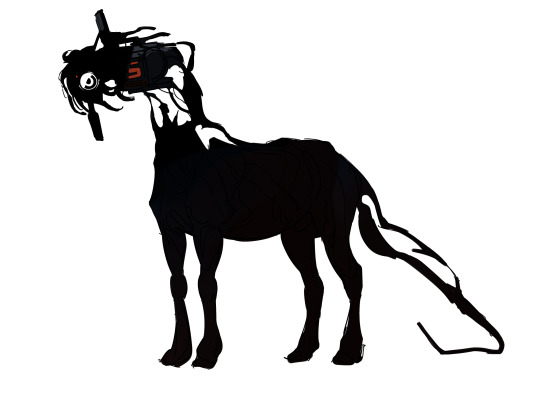
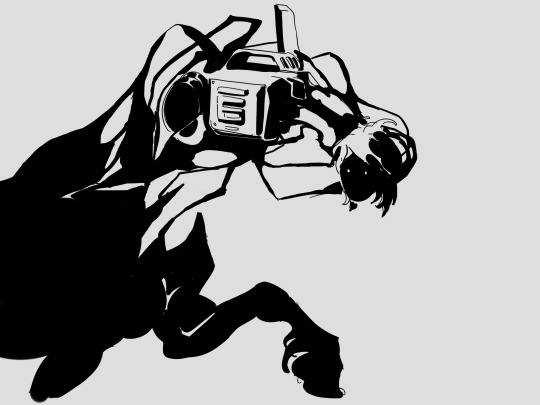
Camera & Action in their own original concept sketches. these were on my other blog but since ppl seem to enjoy the designs i thought i'd have them here as well
ppl may already know that pascal is no longer in the canon of inver, i decided to make a new story :)
so it's about these pseudo-AI assistant/virtual creatures called imimata (singular: imimaton). In the context of the story it's specifically about celebrity culture, virtual pop stars/TV presenters, and labour relations
[copy-pasted explanation from the other blog lol but i have a tag for it here too with a lot more posts!!]
Think of a completely formless seed that, for a fleeting moment, has the potential to become an artificial intelligence, but always changing, with endless permutations and no permanent state of being. when kept within a resonance chamber (the ‘container’ that may be analogue or digital etc), it is fixed into place long enough for it to be able to become. the chamber holds it and allows it to develop instead of dissipate away instantly. the process of development led by external forces - intentional or unintentional - is called 'encoding’. professional encoders will essentially use this shapeless state of being to encode commands, personality prompts, and rules, essentially moulding the thing in the resonance chamber into a form dictated by them. when i say unintentional, i also mean that exposure to any stimulus will always be a learning experience, and the thing will grow and develop no matter what if it first gets fixed in one place. but it’s only referred to as an imimaton once it has been encoded - no longer raw matter, but hammered into shape.
encoding is basically the socialisation of an impressionable thing into a biddable and useful form. in the early Hertzian era (when this technology took off, 1830s ish - crucially, before the commercial application of imimata, when they were curious playthings for idle Great Thinkers), encoding was a process of conversation lasting many years, often for purely philosophical purposes, literally talking at something until it talked back. prior to this, natural magnets could be used to fix a proto-imimaton, and people would think of them as similar to homunculi. in today's digital era, encoding takes the form of inserting storage media into the chamber, essentially running a program in a computer that reduced the encoding process to a few seconds and the flip of a switch. Pascal is an example of a Hertzian imimaton, composed of information stored in radio waves rather than a digital storage medium (basically - he's analogue)
outside of encoding, clauses may be placed upon the chamber itself and these are less socialisation, they do not form the building blocks of an imimaton, they are purely strict rules and routines which it is bound to follow. one such clause could involve the censorship of certain words (so that an imimaton cannot say fuck even if they would otherwise have been able to), or strict boundaries on what information an imimaton is allowed to learn. a common clause also boils down to making it impossible for one to attempt to manifest physically.
Once this was perfected, imimata entered the workforce at the turn of the 20th century.
[...]
When Pascal made his TV debut in 1969, it was hyped up for months with ads which depicted him on set and in more realistic ways (almost appearing to be photographs - some even were!), while public reaction was carefully monitored. This was highly experimental and it still was not known whether the concept of a virtual TV presenter worked, so although they did hype it up, there was a level of caution too so as not to invite negative press.
The first series did not involve public audience members but people from the broadcasting studio standing in for them (this was not made known at the time). They used a combination of camera tricks and graphics to make it feel like he was physically standing in a room with these people (bearing in mind he was strictly contained and had no manifestation outside the broadcast - he was within a container at the base of the mast tower, with a recording device which could cast his image live, so viewers at home were seeing cuts of the Pascal feed and cuts of the physical studio and audience stitched together to appear continuous)
That was part of the gimmick - it was commonly felt that an imimaton should never be permitted to manifest/should have no manifestation, so the fact that he supposedly was manifesting but friendly and contained was a draw. the ads leaned into it quite a lot - marketing copy implying that you could touch him, go on dates with him, etc but always with a cheeky wink, a "not really", the audience at home were in on the secret of it not being real. but it worked really well and was super effective to generate hype and it sparked an entire golden era of imimata and manufactured celebrities (but Pascal remained notorious for being one of the only ones that could believably interact with a studio audience in an unscripted manner, due to his 'maturity' as an imimaton, having been brought up in the 19th century conversational era of encoding, raised on a diet of talking to philosophers)
The second season of the show came out quickly and to much anticipation, and with members of the public actually participating for the first time. The broadcasters set up a wall of CRTs in the studio which would display him to people on-set, and wired up each audience member with a microphone so he could hear them too (he appeared to see them well enough through the camera equipment). he was excited to interact with them and they liked him too, but he always had this slightly mean streak which his broadcaster tried hard to soften. but the meanness worked really well in the reality/game show format where half the entertainment is watching audience members get dunked on sometimes
Episodes could be produced at a rapid pace by taping multiple at once - three identical sets were built for season 3 allowing for three episodes to be filmed at once because he could of course interact with everyone freely and essentially be in multiple places at once. this was also where the first issues showed up on-set - he began to miss his timing cues, arriving just a bit too late to the stage, or taking slightly too long to finish his nightly sign-off. this was not apparent publicly as the episodes were not shown live and could be edited, but any member of the public who was on the show was often hounded after by superfans, so some stories did come out about Pascal's 'odd' behaviour on set. there was a behind-the-scenes documentary made about the entire producing process in season 3 as well, which included some interviews with Pascal himself, but mostly consisted of his handlers and technicians excitedly explaining the broadcast apparatus and containment devices and so on.
Following The Incident, the rare copies of this film became highly sought-after by collectors.
#(calling the horseys separate names is just a joke. they are all pascal)#imimata rampant#Unicorn is also in this story too :) he is a digital pop star who debuted in 2003 and looks like a y2k fan's wet dream
1K notes
·
View notes
Text
on reconstruction and historical linguistics
to follow up on today's reblog, i want to comment briefly on the apparent misapprehension that linguistic reconstruction is just guesswork with a fancy name, because that's not accurate!
reconstruction is based on specific, well-attested constraints of linguistic development. we know from centuries of investigation that languages tend to change in predictable ways. we also have a decent understanding of the complexities introduced by phenomena like language contact, which can result in borrowing on multiple structural levels. our methods are well established and borne out by evidence.
comparative reconstruction involves applying these known constraints ("rules") in reverse on a collected body of words in related descendant languages. when possible, we also incorporate historical written evidence, which often provides midpoint references for changes in progress. it is always recognized by historical linguists that reconstruction can be imperfect; we cannot know what information has been lost.
the results of reconstruction can be mixed, but i'll let campbell (2013:144) explain:
How Realistic are Reconstructed Proto-languages? The success of any given reconstruction depends on the material at hand to work with and the ability of the comparative linguist to figure out what happened in the history of the languages being compared. In cases where the daughter languages preserve clear evidence of what the parent language had, a reconstruction can be very successful, matching closely the actual spoken ancestral language from which the compared daughters descend. However, there are many cases in which all the daughters lose or merge formerly contrasting sounds or eliminate earlier alternations through analogy, or lose morphological categories due to changes of various sorts. We cannot recover things about the proto-language via the comparative method if the daughters simply do not preserve evidence of them. In cases where the evidence is severely limited or unclear, we often make mistakes. We make the best inferences we can based on the evidence available and on everything we know about the nature of human languages and linguistic change. We do the best we can with what we have to work with. Often the results are very good; sometimes they are less complete. In general, the longer in the past the proto-language split up, the more linguistic changes will have accumulated and the more difficult it becomes to reconstruct with full success. (emphasis mine)
or, to quote labov's (1982:20) pithier if less optimistic approach:
Historical linguistics may be characterized as the art of making the best use of bad data, in the sense that the fragments of the literary record that remain are the results of historical accidents beyond the control of the investigator.
in sum, historical linguists are very realistic about what we can achieve, but the confidence we do have is genuinely well earned, because linguistics is a scientific field and we treat our investigations with rigor.
---
Campbell, Lyle. 2013. Historical Linguistics: An Introduction. Cambridge, MA: MIT Press.
Labov, William. 1982. "Building on Empirical Foundations." In Perspectives on Historical Linguistics. Winifred P. Lehmann and Yakov Malkiel, eds. Pp. 17-92. Amsterdam: John Benjamins.
#linguistics#language#historical linguistics#i got to hang out with my grad school colleagues and talk about one of my dissertation texts today so i'm in my academic feelings#also it's friday and i'm allowed to have a little fun (yes this is fun) (i'm a phd what do you expect)
466 notes
·
View notes
Note
Do you know if this guy just hates Camille or is any of this is true? Like he was "so little respected" and "never entrusted with duties of any consequence"?

I'm reading "The Twelve Who Ruled" by R.R. Palmer because it got recommended a lot on reddit, but this guy seems kind of mean. He refers to Camille's writings as "childish pretentions to learning" & even goes out of his way to say how he didn't die "with fortitude" like everyone else.


His Wikipedia article says he was begging for his wife's life, which paints a totally different picture. But I'm having trouble getting access to a lot of the books that I see referenced, and I don't know if that's a romanticized version or if Palmer's is slanted.
Camille's last letter got its hooks into my brain and I can't stop chasing down his story! People are complicated & I love that he might've been an awkward little weirdo, but also I don't know that the sources I have available are particularly unbiased.
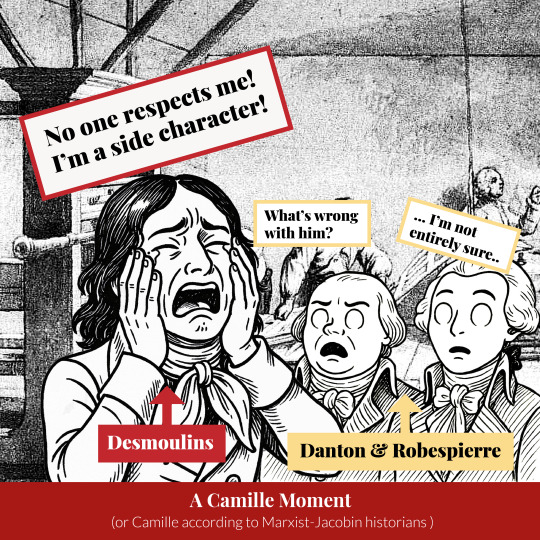
Camille Desmoulins: A kind of child in politics?
First of all, I have to say I adore this question. Genuinely. Thank you, @secondjulia, for sending it in.
Why do I love it? Because it lets me say the obvious thing that somehow still needs saying: Camille Desmoulins, like everyone else in the 18th century, was a person. Not a metaphor. Not a cardboard cut-out. Not a tragic hero cooked up by a novelist. An actual human being. Loved by some, ignored by many, hated by others.
I’ve said this before, but it bears repeating: historical figures were people. They sulked, lied, procrastinated, wept, and occasionally changed their minds.
And so, as with Robespierre, Danton, Saint-Just and the rest, our understanding of Camille depends far more on who’s writing than on Camille himself. The sources, primary or not, often reveal more about their authors than their subjects.
So what about Palmer? I like Twelve Who Ruled. It’s a sharp piece of scholarship. Palmer had a clear aim: to explain the Committee of Public Safety. And that’s what he did. The book is about them, told from their vantage point.
Palmer reconstructed Year II from the Committee’s outgoing paperwork and their own letters. In other words, he built his narrative from the records of the people who had Desmoulins arrested. Naturally, their prejudices bled through. When Saint-Just called him a Danton’s vain syncopath (1), Palmer more or less nods along and copies it out.
So, was Camille really a political child whose death meant nothing? As always with history, it depends who you ask.
A Short (and simplified) overview on Historiography of Camille Desmoulins
Nineteenth-century French historians such as Michelet, Lamartine, Thiers and Claretie, cast Desmoulins as a central (if impetuous) voice of 1789: the spark that roused Paris, an eloquent pamphleteer elected to the Convention, and a tragic victim of the Revolution’s tendency to eat its own children.
Twentieth-century assessments split. The Marxist-Jacobin line, via Mathiez and Lefebvre, paints Camille as vain, erratic and unserious. In this respect, Palmer follows this view, no surprise, since he admired Lefebvre and borrowed from his intellectual conclusions. And Palmer, after all, wasn’t writing a book on Desmoulins.
Revisionist historians , from J. M. Thompson to François Furet, pushed back, reframing Camille as a voice of early dissent, warning of the Republic’s descent into purges and paranoia.
Since the 1980s, press historians have looked more closely at his journalism. Révolutions de France et de Brabant, Le Vieux Cordelier. They have found serious contributions to republican thought and critiques of the Terror.
Today, writers like Hervé Leuwers depict him as a thoughtful Enlightenment man of letters, a proto-republican, and a principled journalist whose private letters radiate clarity, courage and, and, above all, love for his family.
Palmer’s charges against Camille
So, given that the historiography is anything but settled, let’s examine what Palmer actually accuses him of:
Political immaturity and irrelevance. Desmoulins was "a kind of child in politics". So unimportant that he was never given any serious responsibility.
Mock-intellectualism and distortion. He had “childish pretensions to learning” and twisted facts for the Indulgents’ cause.
Cowardice at death. He alone struggled at the scaffold.
Cruel hypocrisy. He was cruel and mocked others for dying badly but couldn’t manage composure himself.
Undue familiarity. People called him “Camille”, and that, somehow, is evidence of his unseriousness.
So, with all the charges laid out, let’s get into it
1. Political immaturity and irrelevance.
This is nonsense.
Desmoulins wasn’t just writing pamphlets in cafés, the 18th-century equivalent of a keyboard warrior. He was elected Deputy for Paris from 1792 to 1794. Convention transcripts show him speaking at the king’s trial and submitting official opinions on the veto, the royal succession, and the state of army morale.
He sat briefly on the Commission of Public Safety (March 1793) (2) and then on the Committee of War, submitting papers on military supply and recruitment. In February 1793, he alone was tasked with inspecting Didot’s paper mill (3), which was vital to revolutionary printing.
Danton and Robespierre also used him strategically. They gave him documents and political cover to attack the Hébertists in Le Vieux Cordelier (4). Even Palmer concedes that his Histoire des Brissotins (5) was so influential that entire pages were quoted in the Girondins’ indictment.
So no, he wasn’t kept out of power because no one respected him. The Committee turned on him when he demanded clemency, not because they thought he was harmless, but because they knew he wasn’t. They understood perfectly well that his words could shift public mood, that he could cause real trouble. If he were just Danton’s decorative shadow, there’d have been no need to silence him. But they arrested him, too. That tells you exactly how seriously they took him.
2. Mock-intellectualism and distortion
Camille’s notebooks are still in the Bibliothèque Thiers. Marginalia in Cicero, Tacitus, Livy, Rousseau. Not bad for a political child…
In La France libre he coined “liberté, égalité, fraternité”. In Révolutions de France et de Brabant, he cites Grotius and Vattel to sketch a law of nations. I don’t know about you, but I wouldn’t call that childish. When I was a child, I was reading Harry Potter, not Grotius.
Palmer accuses Le Vieux Cordelier of distortion. But what did Camille actually write? He warned of secret denunciations, lawless arrests, and the slow crawl toward dictatorship. Robespierre himself approved the first three issues until Camille turned the critique on the Committee itself and dared to demand clemency. That was the line. Truth was acceptable, so long as it didn’t threaten the precarious stability of the revolutionary government.
And let’s be clear. I’m not in the “Robespierre was a tyrant” camp. He wasn’t. Not even a little bit. But Year II was an unholy mess, and Camille was right to say so.
3. Cowardice at death.
First of all, I don’t know about you, but if I were about to have my head cut off for writing a few pamphlets, I’d be a little miffed too. But let’s set that aside.
Did Camille lose his composure on the scaffold? Yes, he did. Eyewitnesses like Beffroy de Reigny (6) saw him in the tumbrel, shirt torn, laughing convulsively, looking unhinged. He did not cut the calm figure Danton did beside him.
But was he truly afraid of death itself? Perhaps. He had every reason to be. That would have been natural, even expected. Yet his final letters suggest something else. In one of them, he wrote: “My head rests on the pillow of my writings... they all breathe philanthropy.” (7) He knew why he was being killed, and he accepted it.
So why the breakdown? In court, when Fouquier-Tinville (8) dragged Lucile’s name into it, Camille lost control. “They want to murder my wife too!” (9) he shouted, and had to be forced down. Perhaps his despair was not for himself, but for her. For the child they had. For the family he knew he was leaving behind, and feared might follow him to the scaffold.
Palmer was writing in an era that still venerated stoicism as a masculine ideal. Men were expected to die well, quietly, without emotion. It is a ridiculous standard. Always has been. Men, 18th-century ones included, are allowed to be human. A thirty-four-year-old husband and father, facing a violent end and the likely execution of his wife, is allowed a moment of collapse.
Yes, Camille broke down physically. So did Fabre d’Églantine (10) and Chabot (11), though Palmer leaves them out. But courage should be measured by your posture in the cart. It should be measured by whether you stood by your words. Camille did. He never disowned what he wrote. He died with it, and with all the fear that came with being someone who loved deeply.
4. Cruel hypocrisy
Camille Desmoulins was a brilliant journalist. In my view, the best of the Revolution. His style was elegant, funny, and direct. He picked his topics shrewdly and knew exactly what would catch the public’s attention. At times, he was cruel, but cruelty was the currency of the era. No one ever accused Marat or Hébert of restraint…
He was a masterful satirist. Early in the Revolution, he mocked the high and mighty with gusto. In Révolutions de France et de Brabant, he took aim even at the executioner Sanson (12) and earned himself a libel suit. In Discours de la lanterne, he justified the lynching of aristocrats. The title alone was a nod to the violent street slogan “à la lanterne” (13). He made his position very clear.
And he was hardly an outlier. Violent rhetoric was everywhere. It was the daily fare of the press, speeches, and yes, even the national motto. “Liberté, égalité, fraternité ou la mort.” (14) This was a very intense time.
That said, by the time Year II descended into madness, Camille had changed his tune.
In Vieux Cordelier no. III, he called for clemency and due process, an unpopular stance in the Convention, though wildly popular in the streets. The issue sold out across Paris. Robespierre had to speak on his behalf at the Jacobins just to stop his peers from tearing him apart.
By the end of 1793, Camille had become a humanist. He had moved from vengeance to justice. He had seen what violence looked like when taken to its logical end. That was not hypocrisy. It was growth.
5. Undue familiarity
This one barely deserves a rebuttal. Yes, people called him “Camille” instead of “Desmoulins”. In the West, they also called La Rochejaquelein “Monsieur Henri”, and still do. It did not make him any less of a general. It was not disrespect. It was affection. Perhaps even popularity. Was it a bit infantilising? Maybe. But that is hardly an indictment.
Conclusion
Every one of Palmer’s criticisms, whether it be childishness, flippancy, uselessness, shallow intellect, fear, hypocrisy, or lack of seriousness, collapses under scrutiny. Read the transcripts. Read the pamphlets, the letters, the modern biographies. You will not find a clown. You will find a sharp, impassioned writer. Not a child, but a man whose conscience could no longer stomach what the Revolution had become.
Palmer was writing during the Second World War. He valued discipline, executive clarity, and the capacity to act decisively. Desmoulins, a polemicist and tribune rather than a minister, naturally fell outside Palmer’s pantheon.
So, who was Camille? He was a man. He had friends. He was loved.
That may not have counted for much in Palmer’s eyes, but it was precisely what made Camille so effective. He moved people. He mattered to them. He made them listen.
Robespierre put it best during one of the most memorable exchanges between them. Camille, instead of keeping quiet and letting Robespierre speak for him, insisted on defending his own writings. Robespierre, exasperated, said: "Learn, Camille, that if you were not Camille, we might not be so indulgent with you." (15)
That tells you everything you need to know.
Notes
(1) Saint-Just had a busy spring in 1794. As the Committee of Public Safety’s mouthpiece, he was repeatedly sent to the Convention to justify the arrests of Danton, Desmoulins, and the rest of the Indulgents. On 31 March, he made it perfectly clear what he thought of Camille. In his view, Desmoulins was a vain little man, too foolish to think for himself and too dazzled by Danton to notice he was being used.
(2) Not to be confused with the more infamous Committee of Public Safety. Desmoulins briefly served on the Commission of Public Safety in March 1793. This commission was established to protect the young Republic from internal and external threats. It would eventually evolve into the Committee we now know.
(3) The Didot family were renowned French printers and typographers. Their paper mill was instrumental in producing the high-quality paper used for revolutionary materials, including assignats (paper money).
(4) Le Vieux Cordelier was the last journal founded by Desmoulins, launched in December 1793 to attack the radical Hébertists. It ran for seven issues, the last of which appeared posthumously.
(5) In May 1793, Desmoulins published Histoire des Brissotins, a pamphlet attacking the Girondins, particularly Jacques Pierre Brissot. It portrayed them as enemies of the Revolution, helping to discredit them and strengthen the Montagnards’ hold on power.
(6) Louis Abel Beffroy de Reigny, known by the pseudonym "Cousin Jacques", was a French dramatist and journalist. He is best remembered for his satirical commentary during the Revolution.
(7) Original French: "Je repose ma tête calmement sur l'oreiller de mes écrits... tous respirent la philanthropie."
(8) Antoine Quentin Fouquier-Tinville served as the public prosecutor in Paris during 1793–1794. He was responsible for leading many of the key trials of the Terror, including those of Desmoulins, Danton, and Robespierre.
(9) Original French: "Ils veulent encore assassiner ma femme !".
(10) Philippe-François-Nazaire Fabre, known as Fabre d’Églantine, was a French actor, playwright, and politician. He helped create the Revolutionary calendar and was a close ally of Danton. Accused (rightly) of corruption, he was executed alongside Desmoulins in April 1794.
(11) François Chabot was a former Capuchin friar who became a radical Jacobin and Convention deputy. He was implicated in financial scandals and executed with Danton and Desmoulins in April 1794.
(12) Charles-Henri Sanson was the official executioner of Paris throughout the Revolution. Desmoulins satirised him, claiming he dined with aristocrats , a jab that earned him a libel suit.
(13) The phrase “à la lanterne” was a revolutionary slogan calling for perceived enemies to be hanged from street lamps.
(14) The motto of the First Republic was "Liberté, égalité, fraternité ou la mort" or "Liberty, equality, fraternity or death."
(15) Original French: "Apprends, Camille, que si tu n'étais pas Camille, on pourrait bien ne pas avoir autant d’indulgence pour toi."
#frev#french revolution#camille desmoulins#history#robespierre#thank you for the question#amateurvoltaire's essay ramblings
113 notes
·
View notes
Text
The Bullying and Doxxing
This has been edited to clarify my points 6.6.2025
It has taken me longer than I would like to put this into words, due to life giving me all the good things I have been working for at once. I am going to make this abundantly clear for everyone.
What happened to Idontevenlikedragonage should have never happened. Not because we are all rainbows and toxic positivity, but rather we as a community should never allow people to feel comfortable enough that they can dox someone. In my thirty one years of existence there has been one cardinal rule of the internet.
If you dont like something or someone's take ignore it.
At the end of the day we all like engaging with media be it on a hyper critical way or on the barest amount of engagement. However it does not matter if it is a survey, an analysis, or someone's opinion. You do not need to escalate to bullying them off the internet and doxxing.
This is different for real beliefs that translate beyond the videogame space such as Zionism, TERF ideologies, White Supremacy, Racism etc. That being said the more engagement you give a piece the bigger platform they have. The best strategy I have seen across social media platforms is blocking and not engaging period.
DOXXING IS ILLEGAL.
The fact this was done on Anon, very clearly illustrates that they know what they are doing is wrong, and they do not want to face the consequences of their actions. However, I am ultimately not surprised as to date to my knowledge this fandom has done the following;
Bullied Jenifer Hepler off the Internet
My fandom knowledge has said this was due to the alleged character assassination of Anders. However someone did bring up Proto-gamergate and while I am still looking into the events leading to her being doxxed and her family threatened but it is possible for these two things to exist in the same space and time. It is still bullying and harassment.
Disclaimer: Her TERF and Zionism ideologies are not condoned
Bullied David Gaider, Mike Laidlaw, Trick Weekes, and John Epler into Locking their Accounts Multiple Times.
I am specifically referencing a group of Solavellan enjoyers known as Sollavellan Wives due to their alarming similarity to Snape Wives from the Harry Potter Franchise. To MY KNOWLEDGE this does not include anyone with nuanced versions of Lavellan, or Solavellans who are capable of disagreeing with the the creators but remaining rational about it. Additionally this comes to mind about Emmerich sleeping like a giraffe or Solas having a breeding kink, the devs are allowed to have fun, they are allowed to not like a character they write. I will be real as a budding novelist and fanfiction author I legitimately do not like some of my characters. I have a character who I literally mentally shake like a maraca because they keep changing what they want. At the end of the day though this does not change my dedication for my characters or the work I will put in to see that their voice is heard.
Hate mobbed A WOC author for her portrayal of Vivienne, using the fic as an example of systemic violence against WOC characters, and Improper Tagging.
Bullied Voice Actors and Devs for having different opinions on the characters.
Bullied Concept Artists for releasing concept art.
Y'all need to learn to enjoy life and nature more, I am tired of seeing creators and people who simply enjoy the game bullied for daring to have a different opinion. There is a difference between bigotry and use of stereotypes and someone genuinely having an opinion for no reason that the media you consumed is not great. The above actions are not the fault of the victims but rather the so called alleged fans who decided to bully them off the internet. Congratulations you are as bad as the Star Wars Fandom and that is not a compliment.
DA is what you make it, Veilguard is what you make it.
I have been in this franchise since ye-olden days and I have enjoyed every minute of it. I have also actively enjoyed Veilguard to the point it is competing with my UNMODDED Inquisition run on XBOX for playable hours, mind you this was when you had to leave the machine on and the game running for the Wartable to it's thing.
Also if by some miracle I have mutuals or followers/following that are contributing to this bullying and doxxing bullshit in the fandom. Please do reach out and let me know. They do not speak for my beliefs or opinions. Fandom should be our place from the world to take our selves less seriously, and enjoy the media we all love.
Racists, TERFS, Zionists, and those practicing other forms of Bigotry please exit stage left. You are not welcome here.
#dragon age#dragon age the veilguard#da fandom critical#fandom critical#doxxing is fucking illegal#seriously I would like to know why the fandom has always been like this#however I do not know#all I know is this round some of yall are especially toxic little turds /srs
83 notes
·
View notes
Note
In the twilight universe, do you think there were vampire Neanderthals?
No.
I think it's likely vampires haven't been around all that long in the world of Twilight.
For reference, the oldest vampires we meet in canon is 4500 years old and Neanderthals went extinct 40,000 years ago.
The main arguments against neanderthal vampires:
The population problem One vampire who feeds only when he is hungry will kill one person every fortnight, or 26 people in a year. A vampire who doesn't restrain himself has no reason not to feed more often: as has been discussed on this blog before, without the Volturi there is no need for restraint and the human population would have collapsed. From what we learn from the newborn wars and Jasper's explanation of why they happened, the rule of vampire population expansion is the same as any other organism: they expand until they run out of food and space (as there are no external population controls such as epidemics or natural predators for vampires). In other words, assuming vampires existed since the Neanderthals, and assuming there were no prehistoric Volturi, vampires would risen in numbers until they went the way of the reindeer at St. Matthew's Island. There would not be a Twilight book series.
The lack of evolution (or: why no diversity in vampires?) While 40,000 years is not much in an evolutionary perspective, it is not a blink of an eye either. One of the reasons why I don't think vampires have been around for very long is that, assuming venom is biological, and not a supernatural magic agent that will simply never change, the uniformity with which it behaves implies there is no variation between the venom in Bella or the venom in Aro. Everyone experiences the exact same symptoms of vampirism: the transformation carries the same pain and even duration for everyone, with only individual differences (Bella's being shorter is both explained in-universe and, considering we have detailed information on the transformations of Carlisle, Edward, Rosalie, and Emmett, seems to truly be individual), and vampires are all similar with the same sets of characteristics, strengths, and weaknesses. There are no regional differences from what we learn in canon either. And yes, I do think in 40,000 years there would have been a rise in differences. If a coven finds that vampire A's newborns aren't in as much pain as when vampire B bites a person or the transformation is faster, then vampire A gets to bite humans they wish to keep. Similarly, two vampires raze a village, both leaving behind bitten survivors, one vampire's survivor is in much less pain and able to hide himself until the transformation is complete and the other is not. An even clearer example is that one vampire is better able to control his thirst will successfully create more vampires than the vampire who isn't. For there to be no apparent mutations on a global scale, venom can't have been around that long. (I'll even go ahead and say we're pushing the absolute upper boundary by having vampirekind be several thousand years old, but strict population control having been in effect for over a thousand years does make me a little less snippy about it. Thank you for the service done to nerds, Aro.)
The civilisation and collective history problem In short: however impressive vampires were, they were not numerous enough to impact human history in such a way that we have inexplicable... holes. They did not prevent human civilisations from arising and they did not leave a legacy that could not go away over the centuries. There weren't many of them, and I think the fact that human civilization was able to rise in the first place indicates that civilization predates vampires. Otherwise, humans start gathering in one spot -> vampire is drawn towards hunting grounds -> the humans die or flee -> cities and centralization doesn't happen. Unless there were proto-Volturi, or a natural predator since extinct, humans civilization must have already existed before vampires did.
A few additional thoughts that neither prove nor disprove neanderthal vampires:
The inconclusivity of early history Prehistoric is what we call human history from before recorded history. We know humans existed and made tools and art for tens of thousands of years before the Epic of Gilgamesh was written, but we will never know any of their names nor their history because none of it was recorded. This is what makes them prehistoric. If there were prehistoric vampires and covens, however, then vampires are looking at a very different history of the world. The ancient covens would go back much further than Amun and his lost Egyptian coven. Would Bella necessarily hear about this during the course of the books, no. Further, the Dacians updating their name to become the Romanians, while the Slovakian Tanya, Irina, and Kate become the Denali because they moved to Denali, and the Cullens being the Olympic coven even though their founder and leader is British, means that vampire coven names will come from the contemporary name for their territory. This means that even if the Egyptian coven was actually older than Egyptian civilization, and originated someplace else, convention would indicate that they would still be called the Egyptian coven. Coven names, and known history of covens, does not disprove Neanderthal covens. One can wonder why the earliest vampire conflict brought up in canon is centralized around the Middle East, where the Romanians tried to expand only to meet pushback from the Egyptians. One can wonder the Egyptians were only facing territory dispute from the Romanians or if there were other covens pushing against their borders from other angles, but that wouldn't prove anything either way in terms of these vampires' age.
The lack of predators The shapeshifters of La Push are proof that there is magic in the world of Twilight, and magical humans who, when threatened by vampires, will become able to protect their communities. The fact that they are so unheard that vampires walk around with no fear whatsoever of predators can mean the Volturi (not unlikely, it's hinted at even) or these predators haven't had a chance to become established quite yet. Perhaps this is what the Children of the Moon are, we know very little about them, but we do know they feed on humans and can both kill and be killed by vampires, and they lost the long battle in the long run. They don't seem to me like creatures evolved specifically to kill vampires.
TLDR: I don't believe in neanderthal vampires because there wouldn't be a canon if there had been any. However, we know next to nothing about early vampire history, so while I am inclined to believe Amun was among the first ever vampires they could be older.
84 notes
·
View notes
Text

Although human civilization on Qefre is a couple of thousand years old, it has developed along idiosyncratic lines due to the existence of a planet-wide teleporter network left behind by the long-departed terraformers. These teleporters are essentially stone rings a couple of meters across that can instantaneously exchange everything in a spherical bubble inside them with a similar bubble inside another teleporter (usually including a flat stone platform that provides a convenient surface to stand on). Although their capacity is limited--you can move a lot more people and certainly far more goods by train or ship than you can by teleporter, even if those conveyances go a lot slower--they allow far-flung cities to cheaply stay in close communication with one another.
The basic political unit of Qefre is not the state but the rashun, a kind of ritual-political association tasked with managing the eruni, the logistics management system that controls access to recovered ancient technology. The terraformers seemed to use the eruni as a kind of basic permissions system to distribute and manage responsibility for the planet-wide terraforming infrastructure and its supporting technology; the powerful nature of the eruni and the need to use them responsibly meant that the planet's human inhabitants quickly developed sophisticated social systems for protecting them against misuse, which inevitably became entangled with questions of political power and competing interests between social groups. Rashun became landholding organizations early in Qefre's history, and soon supplanted most early proto-states in regions of extensive human settlement.
In the modern era, rashun club together with local governments and private political associations into "circles" which undertake most low-level administrative functions; these small-scale circles are in turn grouped into larger planet-wide circles, of which there are about fifty; and these larger-scale circles in turn are grouped into ten loose associations, which collaborate to manage affairs of regional or global interest. Since circles can hold territory basically anywhere within the region of human settlement, there has in practice been a strong pressure toward institutionalizing various forms of collaborative and representative government at all levels in order to prevent an absolutely sclerotic degree of political deadlock strangling economic growth.
Not that this hasn't been an issue in the past; indeed, much of Qefre's history has been an endless series of petty local wars, some rising to the scale of planet-wide affrays, with the fragmented structure of territorial control only serving to increase the amount of chaos when violence did break out. Eventually the largest cities, including all the teleporter-networked ones, got so sick of this state of affairs that they ganged up to completely expel the rashun from their immediate territories, and implemented a "power-sharing" agreement that was really an early form of representative democracy, which came to have a profound influence on the internal administration of the rashun themselves.
When the Western Territories were opened up by the discovery of the teleporter at Ar-Amal, the independent cities and the rashun hammered out a set of agreements to prevent a destabilizing series of landgrabs in the surrounding region; but now that the Territories have a large native-born population, many have begun to grumble that they are simply living under a kind of shared fiefdom, quite different from the actual self-government that the cities in the east--or, indeed, the subjects of the modern, collaborative rashun--enjoy. There is a growing local home rule movement, which envisions something quite different from the governments of the east for itself: exclusive territorial sovereignty, with no role at all for the Delegations in its internal affairs. Opponents argue that this is preposterous: that not even the haughtiest of the eastern cities could get away with demanding complete political autarky. To which the Territorialist answer is that all the eastern cities are equals in political affairs, and their political affairs (and political interests) are irrevocably bound up with their neighbors, in a way that is very different from the subordinated and exploited Western Territories. It seems to be an intractable conflict, where neither side is willing to entertain any notion of compromise, nor is it clear what such a compromise would entail. How it will resolve ultimately is anyone's guess.
#worldbuilding#tanadrin's fiction#qefre#the humans on qefre know the planet was terraformed in the distant past and that they're not native#but don't have a clear idea of how they got there#or where they came from#the landscape is still scarred here and there#the aftermath of apparently vicious wars fought with terrible weapons#but whether it was the terraformers or the ancestors of the present-day human population that fought those wars#is anyone's guess
67 notes
·
View notes
Text
Still on my dragonborn hyper-fixation bs because of Baldur’s Gate
(in between violently resting my wrist because carpal tunnel *and* cysts popping up right on in there)
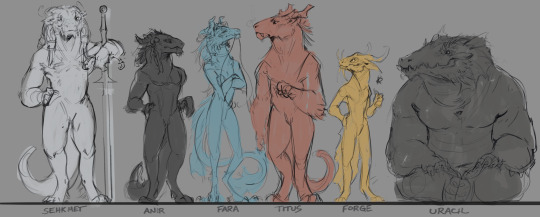
I started this just practicing simplifying different body types, I think I still have a lotta room to improve; but, what this ended up being was trying to see if I could kinda break up my dragonborn designs to have more diverse facial structures based on different creatures.
Going way too in depth under the break (like a lot, be warned)
Shocking no one, I used a little bit of real scientific theory in what I based each chroma pictured here on.
White Dragonborn
Sehkmet is an outlier however because I mostly use monitor lizards for her references and there’s uh, not too many reptiles in the cold areas white dragons usually reside in. But I can apply the volume rule! Which summarized is why there were so many megafauna during ice ages, the more volume an organism possesses, the more efficiently it retains body heat.

So with more practice honestly, I’d like to get better at drawing her bigger. But essentially in my head, white dragonborn would be the largest chroma of dragonborn on average, Sehkmet herself is just grazing 7’
They have an easier time packing on fat and muscle and can deal with cold weather the best with a dense layer of fur/proto-fur like structure that covers the initial base of scales
Black Dragonborn
What I recall of the normal habitat of black dragons is that it tends to be swampy. I designed a crocodile based black dragonborn a long time ago, and just pulled from there. So I leaned slightly into basing them on piscivorous reptiles. Semi-aquatic adaptations leftover, even if they don’t live on coasts or in marshes.
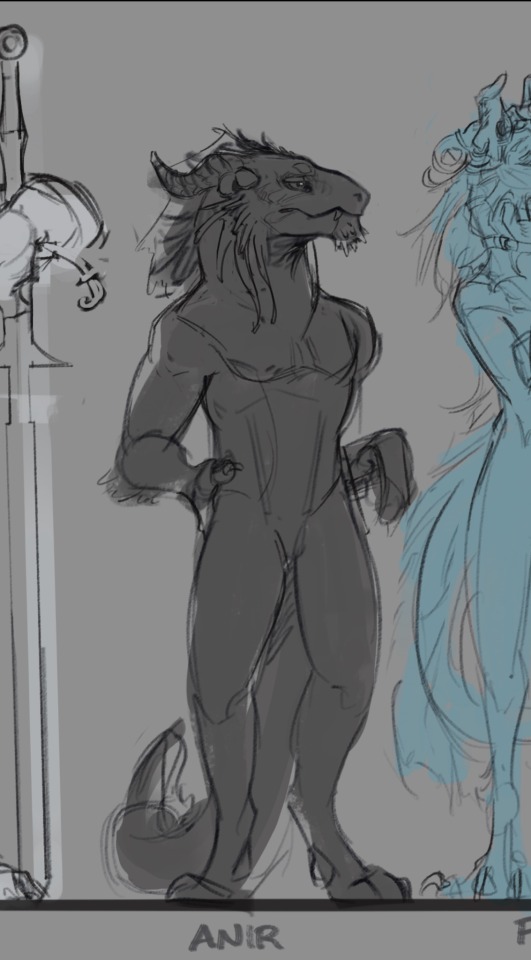

So thick paddle-like tails are considered the norm in black dragonborns, I think a cool trend that’s be popular with younger black dragonborns would be painting the raised flat portions of their tails with bright colors or designs.
Speaking of looks, very shiny scales, any black dragonborns that have fur or feathers would similarly have them very sleek
Much like white dragonborn, they build muscle and fat stores easily, a well-fed black dragonborn could rely on fat stores for almost a year if necessary.
Blue Dragonborn
I’m a bit undecided on blue dragonborn, mainly because I only have designed and played one and don’t know too much about blue dragons off the top of my head, so this is me making stuff up. Since their breath weapon is lightning, I like the idea of leaning towards high altitude animals.
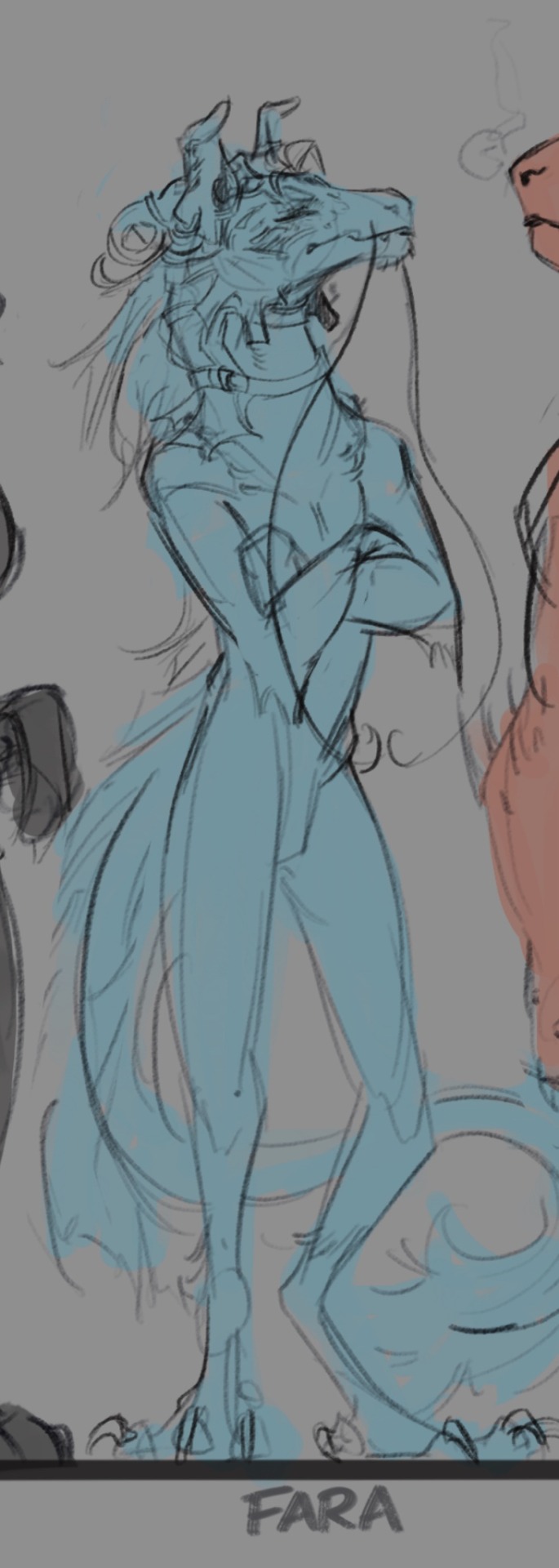
They don’t have as much pressure to be able to continuously produce a lot of body heat or go without food, so on average, they shed extra fat and muscle quickly if not careful bc fast metabolism.
Very colorful, plumage and frills type, they’re pretty boys I don’t make the rules.
Great eyesight, especially if they lean more bird like. Rip Fara, eyes taken from you too soon (ignore the fact it’s my fault)
Red Dragonborn
I wanted to get a little prehistoric with red dragonborn, canonically red dragons are pretty evil aligned and malicious, so I wanted to make red dragonborns look a little exotic(?). Give them a facial structure that to other species and even dragonborn might be difficult to read (permanent rbf?). Red dragons tend to favor badlands, mesas, and mountains which is very fun.

Titus is a bit of a special case, he’s got a case of too-hot-ouchie-itis. Aka, the peril from wof treatment. Too hot to touch. But on average, red dragonborn don’t run as warm as would be expected. They’re from hot climates so their bodies wouldn’t need to have gotten good at producing high body heat
On that note, they tend to not be fans of cold weather. Dragonborn aren’t reptilian or cold-blooded, so it doesn’t have any extra negative impact. RDs just tend not to enjoy it
They got beef, muscle development is top tier. A lot of RDs naturally have pretty dense musculature but it’s not the most obvious
I like the idea, with red dragons being pretty quick to violence, that RDs skin is kind of loose around the neck and thicker than most other dragonborn
Gold Dragonborn
Ok, here’s where I had very little to go off. Gold dragons are solitary, regal, and not picky about environment from what I could find. So I said fuck it, they’re snakey, idc if some people have preconceived ideas that snakes are evil. These dragons and dragonborn are snakey. And I also, admittedly, don’t have a lot of ideas of common traits or things like the other chroma as of now ;-;
Anyway, this has been another instance of: *putting too much thought into arbitrary things to justify why I gave a dragonborn a crocodile face and another dragonborn a snake face*
#art#digital art#character design#dnd art#dnd#dnd character#artists on tumblr#bg3#bg3 dragonborn#dragonborn#furry#bg3 tav#character art#dnd oc
71 notes
·
View notes
Text
examples where "man of his times" can be used:
george catlin (1796-1872), who argued that indigenous americans should be left free on the national parks and subject to "natural law" because he'd spent years with different nations and was scheming to give them control of all the national parkland teddy roosevelt had just set aside from speculation. he made a base political choice to liken the american nations to wildlife in his rhetoric because it played very well with noble savage sensibilities.
william bartram (1739-1823), who fucked off from the revolutionary war to spend time with indigenous nations and wrote a book about "plants" where he spent half of it vagueposting at people he went to college with (the founding fathers) about how they didn't understand a goddamn thing about democracy and would do better to just fucking listen to our neighbors because as he saw it, the american revolution was just the changing of seats between tyrants and the idiots in charge were selfish scavenging cutthroats who'd destroy all the beautiful land he'd just taken care to describe. he heavily used noble savage rhetoric to make his point, in between examples of simple, clear, and fair rulings in matters of justice by various chiefs and councils.
louis hennepin (1626-1704), who lied vehemently about discovering the mississippi river in order to steal the influence of the discovery away from this bitch he was forced to travel with, de tonti. de tonti was a proto-capitalist and was determined on claiming all territory and resources upon it for the french crown (all the better to embezzle from), while hennepin was romanced by the democratic customs he saw and wanted european powers to simply ask to use unused land as the indigneous saw fit to grant. he was particularly enamored by the economic systems, which were communal in nature and more christ-like in practice than anything he'd seen in his life. so hennepin fucking hated de tonti and desperately wanted to share what he'd learned in the americas. reports of major discoveries like this were bestsellers among the literate and would be read widely, cementing public opinion in many ways, and it made natural sense to lie, say he'd discovered the mississippi based exclusively on second-hand accounts from the nations he was on friendly terms with, soundly steal a paycheck from de tonti, and sway public opinion towards cultural exchange with another nation rather than brutal domination over savages as much as he could. and he was a franciscan, who at the time had a long tradition of publishing books in popular genres to proselytize.
they wrote some incredibly racist shit pandering to other racists, and they likely saw their arguments as simply logical. but they did it in defense of indigenous nations, in recognition of different customs that were no less worthy than their own and in fact had much to teach.
that's man of his time. not the people who collaborated. not the active imperialists and colonizers. imperialists and colonizers are bad guys. they're the bad guys. for the love of fucking god being conditioned to want glory in war still means desiring the brutality and savagery of european wars of conquest. it's an explanation, not an excuse.
104 notes
·
View notes
Text
🌌 PART I: The Arab Astrologers—Names You Must Know

📝Abū Maʿshar al-Balkhī-known in Latin as Albumasar
Born in Balkh (modern Afghanistan) in 787, a former hadith scholar who turned to the stars in midlife.
His Kitāb al-Madkhal al-Kabīr (The Great Introduction) became the bedrock of European astrology when translated into Latin.
He systematized planetary natures, zodiac signs, houses, aspects, and the elements.
His “conjunction theory” argued that history moves in great cycles, marked by rare celestial alignments—especially Jupiter-Saturn conjunctions, which he claimed heralded the rise of prophets and empires.
"All change under heaven is written first in the sky."
📜 Al-Kindi – The Philosopher of the Arabs
A polymath in the Abbasid court, blending Greek philosophy with Islamic theology and celestial theory.
In De Radiis Stellarum (On the Stellar Rays), he proposed a theory of stellar influence—not superstition, but a natural force, like light or magnetism.
He laid early groundwork for what would become natural philosophy (proto-science), suggesting stars transmit influence through rays affecting Earthly matter and human temperament.
🌍 Al-Biruni – The Observer from Khwarezm
Though more astronomer than astrologer, he cataloged astrology in full without ever endorsing its claims outright.
His Kitāb al-Tafhīm contains precise definitions of astrological terms, planetary motions, and how horoscopes are calculated.
A master of cultural synthesis: he compared Greek, Indian, and Persian systems, noting their commonalities and contradictions.
🕊 Abū al-Rayḥān al-Sijzī & Al-Zarqālī – Instruments of the Sky
Developed the astrolabe, armillary spheres, and zij tables—astronomical charts used by astrologers to pinpoint planetary positions with astonishing accuracy.
🪐 PART II: What the Arabs Contributed to Astrology
🧠 1. A Philosophical Foundation
Arabs didn’t just practice astrology—they thought about it. They debated whether the stars compel or merely incline.
Al-Farabi and later Avicenna argued the stars could only affect the body, not the soul—a blend of Neoplatonism and Islamic ethics.
The stars whisper, they do not command.
📊 2. Horoscopic Techniques Refined
Arabs inherited and enhanced horoscopic astrology from the Greeks:
Twelve Houses (Bayūt): Places in the chart signifying career, love, health, death.
Lots (Arabic Parts): Points calculated from planetary positions, like the Lot of Fortune and Lot of Spirit, used to fine-tune predictions.
Triplicities and Dignities: Systems to assess planetary strength.
Interrogations (Horary Astrology): Divining answers to specific questions, such as “Will I marry?” or “Will the king win this war?”
⚔️ 3. Political and Historical Astrology
Astrologers like Abū Maʿshar claimed that world events—plagues, conquests, religious shifts—were written in planetary cycles.
Used to time coronations, launch battles, found cities.
Caliphs would sometimes delay decisions until the astrologers said the heavens were "favorable."
🏥 4. Medical Astrology
Used zodiac signs to diagnose and treat illness—Aries rules the head, Pisces the feet, and so on.
Ibn Sina (Avicenna) himself, though skeptical of predictive astrology, used astrological charts for medical diagnoses, especially in fevers and crisis periods.
🌠 PART III: Astrology in Islamic Society
🌗 Religious Debate
The Qur’an warns against claims to know the unseen:
"Say: None in the heavens or on the earth knows the unseen except Allah." (Qur’an 27:65)
So Islamic scholars:
Allowed astronomy (for timekeeping, Qibla direction).
Permitted astrology only if used to understand natural rhythms—not fate.
Condemned fortune-telling or attributing independent power to stars.
Yet astrology persisted—not as dogma, but as courtly art, folk belief, and scientific curiosity.
🕯 PART IV: The Transmission to Europe
Translations of Arabic astrological texts into Latin via Toledo and Sicily reawakened Europe’s interest in the stars.
Terms like zenith, nadir, azimuth, almanac, and even algorithm come from Arabic.
Albumasar, Albohali, Messahala—all Arabic astrologers Latinized into the canon of European learning.
The Renaissance astrologers (like Ficino and Agrippa) drank deeply from Arab wells.
🌌 In Closing: A Legacy Like the Night Sky
The Arabs did not merely gaze at the stars—they listened to them, charted them, debated them, and passed on their wisdom in tomes that still echo today. Astrology, as they practiced it, was never just fortune-telling—it was philosophy, poetry, medicine, and mathematics entwined in a cosmic dance.











#astro community#astro observations#astrology#vedic astrology#astro notes#tarot#art#poetry#quotes#gaza#Mid century#dark aesthetic#arab scholars#arab#stars#moon#capricorn#leo#cancer#aquarius#sagittarius#libra#scorpio#pisces#taurus#aries#gemini#virgo#zodiac#full moon
31 notes
·
View notes
Text
🌐The Long and Complicated History of the Time Lords: Part II - The Evolution of Gallifrey
When we last left off, the universe had just stabilised, acquired dimensions, and was promptly infested with godlike entities, temporal parasites, and beings who eat time for breakfast. Now, finally, we zoom in on one red-grassed planet near the heart of Mutter's Spiral.
Welcome to Gallifrey.
Disclaimer: Information on the creation of existence and a whole society is obviously mixed. GIL has waded through many contradictions to provide you with the most cohesive, structured, and key details of how it all came about, but there is room for interpretation.
🪖 Gallifrey Evolves (Quickly and Questionably)
Life from the Ancestral Cell reached Gallifrey. Between the planet's natural temporal instability and the looming influence of the Untempered Schism, evolution got a bit creative. Rapid psionic development, sudden mutations, and dinosaurs with chitinous plating—you get the idea.
Eventually, sentient proto-Gallifreyans emerged—not from apes, thank you very much, but from time-soaked forms, most likely reptilian or saurian in nature. These beings began to perceive time, collapse quantum phenomena, and impose meaning on the universe. In doing so, they effectively helped invent biodata and the rules of reality as we understand them.
💖 The Shobogans and the Shadow Walkers
These early Gallifreyans came to call themselves Shobogans: shadow-dwelling, fire-wielding proto-humanoids with immense psionic potential. Their proximity to the Schism gave rise to natural time sensitivity.
They were the first humanoids in the universe, and thanks to morphic fields,[1] they seeded the archetype of humanoid life across countless other worlds. This is why so many aliens look suspiciously Time Lord.
The Shobogans believed themselves to walk between light and darkness, science and magic. Hence, the meaning of the word Gallifrey—"they that walk in the shadows."
⚔️ From Bronze to Empire (with Detours into Magick)
Civilisation blossomed. The Shobogans moved from spears to metallurgy, to steam, and eventually to spaceflight. They developed:
Telepathic cultures with emotion-sharing over distances
Old High Gallifreyan, a language that could bend reality [2]
Academia, structured educational systems for warriors and thinkers alike
Religious theocracy, ruled by visionaries and mystics
Their society was deeply influenced by Odic Energy and magickal thinking. Prophets read the future in volcanic vapours, dreams, and spatial fissures.
🚀 Tecteun and the Great Leap Outward
As Gallifrey entered its steam-and-steel era, enter Tecteun. Scientist, wanderer, and morally dubious, Tecteun was the first Gallifreyan to achieve spaceflight. Her ship was primitive and barely functional, but she ventured into the stars anyway.
While she was away exploring, Gallifrey industrialised, warred, and finally unified under the Pythia, a powerful oracle-priestess whose rule blended governance with mysticism. Her visions came from the Crevasse of Memories That Will Be (which is exactly as melodramatic as it sounds), and her temple became the beating heart of the Gallifreyan Empire. Their technological leaps were dramatic. They became a Level 6, then Level 7 society.
They moved beyond the Stellian Galaxy. Gallifreyan colonies sprang up across the cosmos.
🌟 Gallifrey Ascends
Gallifrey's empire grew vast. Its fleets spanned the stars. Colonies were ruled by governors, and Gallifreyan traders, generals, and scientists became legends.
They:
Mastered transduction barriers and pan-dimensional engineering
Developed psychic technology and prophecy-based strategy
Made contact with — and war upon — rival Fledgling Empires[3] like the Carrionites, Weeping Angels, and Osirans
Created myths, fairy tales, and interstellar propaganda still taught to Time Tots today
Religion remained central. The Pythian Order governed with divine authority, guided by the Menti Celesti (see here). Gallifrey was now a cosmic theocracy with industrial reach and psionic might.
⌚ The Age of Heroes Begins
As Gallifrey expanded, so arrived:
Omega (aka Peylix): Visionary, engineer, insomniac. Believed in building a better universe through science, not conquest. Disliked violence.
Rassilon (aka "Rass"): Architect, polymath, red-haired egotist with a flair for destiny. Brilliant at weaponising mathematics. Enjoyed onions.[4]
The Other: A mysterious figure in Gallifreyan history. His name, birthplace, and appearance have all been forgotten, but was rumoured to have extraordinary powers.
Together, they would change the course of Gallifrey.
Assembled from ROOG and TARDIS Wiki
Next Week: Part III – The Rise of Rassilon
Footnotes:
[1] Morphic Fields = A metaphysical field. Stronger in older species, which explains why Gallifreyans have suspiciously wide genetic influence.
[2] Old High Gallifreyan = Not just a language but a reality-altering script probably infused with the powers of Odic energy.
[3] Fledgling Empires = Early galactic powers that challenged Gallifrey's dominance during the Dark Times.
[4] Rassilon's Onion Habit = Possibly apocryphal.
Any orange text is educated guesswork or theoretical. More content ... →📫Got a question? | 📚Complete list of Q+A and factoids →📢Announcements |🩻Biology |🗨️Language |🕰️Throwbacks |🤓Facts → Features: ⭐Guest Posts | 🍜Chomp Chomp with Myishu →🫀Gallifreyan Anatomy and Physiology Guide (pending) →⚕️Gallifreyan Emergency Medicine Guides →📝Source list (WIP) →📜Masterpost If you're finding your happy place in this part of the internet, feel free to buy a coffee to help keep our exhausted human conscious. She works full-time in medicine and is so very tired 😴
#doctor who#dr who#dw eu#gallifrey#gallifrey institute for learning#whoniverse#TOTM: The Time Lord The Myth The Legend#nuwho#GIL: Facts#GIL#GIL: Species/Gallifreyans#classic who#GIL: Gallifrey/Culture and Society#gallifreyan culture#gallifreyan lore#GIL: Gallifrey/History#GIL: Species/Others
23 notes
·
View notes
Note
so it was never an ai to begin with? they just trapped a creature... a myth?
noooot quite. think of like a completely formless seed that, for a fleeting moment, has the potential to become a living thing, but always changing, with endless permutations and no permanent state of being. when kept within the resonance chamber (the 'container' that may be analogue or digital etc), it is fixed into place long enough for it to be able to become. the chamber holds it and allows it to develop instead of dissipate away instantly. the process of development led by external forces - intentional or unintentional - is called 'encoding'. professional encoders will essentially use this shapeless state of being to encode commands, personality prompts, and rules, essentially moulding the thing in the resonance chamber into a form dictated by them. when i say unintentional, i also mean like.. exposure to any stimulus will always be a learning experience, and the thing will grow and develop no matter what if it first gets fixed in one place. but it's only referred to as an imimaton once it has been encoded - no longer raw matter, but hammered into shape.
encoding is basically the socialisation of an impressionable thing into a biddable and useful form. in the early Hertzian era (when this technology took off, 1830s ish - crucially, before the commercial application of these things), encoding was a process of conversation lasting many years, often for purely philosophical purposes, literally talking at something until it talked back. prior to this, natural magnets could be used to fix a proto-imimaton, and people would think of them as similar to homunculi. in the digital era, encoding takes the form of inserting storage media into the chamber, essentially running a program in a computer that reduced the encoding process to a few seconds and the flip of a switch.
outside of encoding, clauses may be placed upon the chamber itself and these are less socialisation, they do not form the building blocks of an imimaton, they are purely strict rules and routines which it is bound to follow. one such clause could involve the censorship of certain words (so that an imimaton cannot say fuck even if they would otherwise have been able to), or strict boundaries on what information an imimaton is allowed to learn. a common clause also boils down to making it impossible for one to attempt to manifest physically.
#imimata rampant#nico is an encoder so he knows all this and he's the pov character. so its not spoiler
50 notes
·
View notes
Text
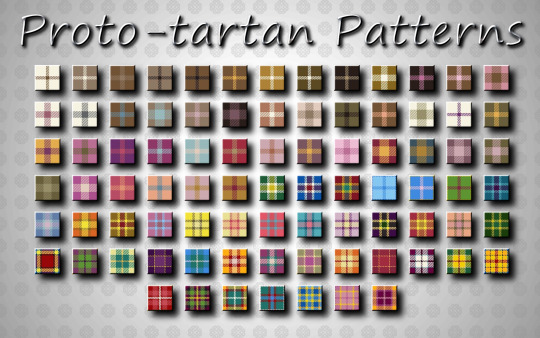
Proto-tartan Patterns
Once my new colour palettes were ready, I could finally move to the thing which prompted their remake in the first place: meaning, a total overhaul of the tartan(-esque?) swatches I use for recolouring stuff.
Remember my old set of tartan patterns? I've been gradually getting less and less happy with them. Sure, they were pretty, no doubt - a little bit too pretty. Kind of complex. Kind of time-consuming to make. Kind of... not screaming 'iron age'. And not at all consistent with the colour palette I was using at the time. So I decided to remake them.
Completely. From scratch.
This time I wanted to be smarter. This time I had a vision. And a plan.
Hear me out.
(or just DOWNLOAD them from my Patreon - as always all free from day one - if you don't feel like reading this dissertation; why does it always get so long ffs...)
So the thing is - we don't know much about how pre-Roman Britons dressed. They left no written records and, as their textiles were, obviously, organic, they decomposed long ago, so archaeology is of little help as well. However, there's one thing we do know, as all ancient writers agree on it: namely, that their clothing was strikingly 'colourful'. Considering Romans themselves had better access to vibrant dyes and textiles, that probably wasn't it; and so it's a truth universally acknowledged (or at least believed) that said 'colourfulness' was a result of insular Celts using multi-coloured patterns, as opposed to Roman monochrome style. How exactly those patterns looked, we have no way of knowing. Some interpret it simply as stripes; others as some chequered patterns; and others dare to call it proto-tartan. I went with the last one.
Trying to come up with swatches which would make sense for those times was a tricky task - you know? Because on the one hand, I didn't want them to be obviously anachronistic; and imagining a life of a Brittonic commoner woman, I could see that she'd have no time and energy left to make literally any of my old tartan swatches. What would a farmer's wife wear? She'd be making her clothes herself, of course - so what would she go for? Something simple, not that time-consuming, not requiring too much concentration. Maybe two shades of natural wool; maybe dyeing some skeins of white wool some easily accessible colour; maaaybe two dyed colours, if she liked to dress up. But dyeing her wool ten different colours and then weaving them into beautiful, perfectly symmetrical patterns, like the ones from my old set? I think not.
Then again, we have that ugly tendency of assuming people in the past were somehow 'lower' then us, especially when it's about illiterate societies. Yet every now and then archaeologists find old textiles which miraculously survived millennia, and time and time again we're flabbergasted by how intricate they are, how well-made, how fine, how... Damn expensive. I have no reason to believe it was any different in case of ancient Britons. Whatever a Celtic chieftess wore, she surely wasn't running around in a potato sack; and considering Roman officials would probably interact mostly with the richer members of the society, it makes sense that their 'wooooow, so colourful' comments were inspired mostly by those upper-class garments.
And so I decided to invent and implement a kind of class-stratification system, i.e. different pattern rules for different social classes. Totally arbitrary, totally made up, totally not backed by any sources - just a simple product of the time I spent wondering 'what would've made sense'. Oh, and this time all the colours come from my new palette(s), so it's all consistent. I found an online tartan maker and got to work.
See? I told you I had a plan.
The free version of the tartan maker let me mix maximum of 5 colours and I happily agreed to this limit, basing the bulk of my rigid social classes' system exactly on this: the number of colours used. Their provenience also played a role. And of course I went for the holy number of 85 swatches - divided into five groups:
Group I - lower class casual dress. Five patterns only in undyed wool, 20 patterns in one shade of undyed wool + one dyed colour. Altogether 25 swatches;
Group II - lower class fancy dress & middle class casual dress. Two dyed colours, only from the northern palette. 20 swatches;
Group III - middle class fancy dress & upper class casual dress. Three colours, whichever, including the imported ones, with the exception of Roman luxury dyes (kermes, turmeric, saffron, Tyrian purple). Again 20 swatches;
Group IV - upper class fancy dress. Four colours, whichever, even the luxury ones. I guess not too many sims could land so high on top, so it's only 10 swatches;
Group V - aka 'when you're the chief of the most powerful tribe on the isle and you've conquered anything of value so you're basically a king'. Five colours, whichever, most swatches with heavy emphasis on the luxury dyes. Another 10 swatches.
Here you can see the difference visualised on a dress I'm currently working on (don't pay too close attention to alignment and such, it's still a wip). For example, a progression of different purple & yellow combos:
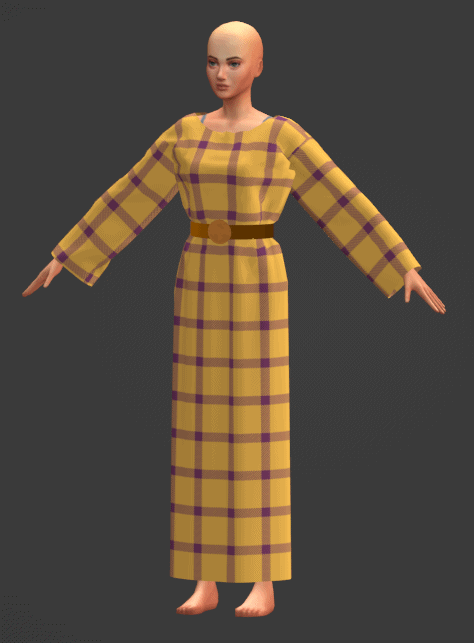
See the difference? We went all the way from birch mixed with elderberry to Tyrian purple mixed with saffron. (Which, btw... Can you get any posher than that???)
Or the progression of reds and yellows. The last swatch looks almost like the first one from the old set (yup, I took lots of inspiration from it when I was struggling to design those 4 or 5 colour combos):
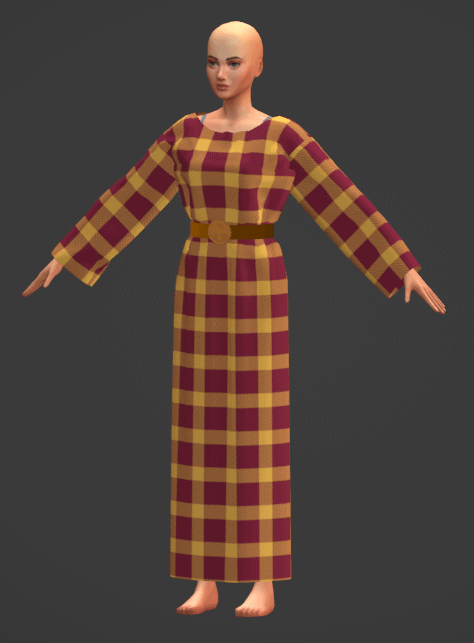
And here another swatch from group V, just because I love it. Perfect for a sim who's rich and not afraid to show it:
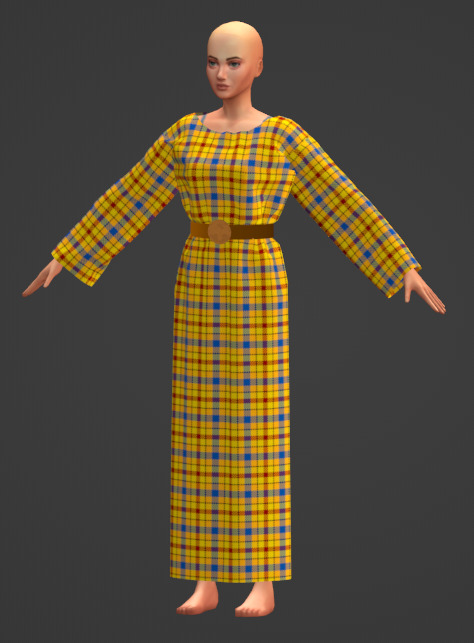
That's woad, kermes, saffron and turmeric you're seeing here. In your face peasants.
So. That was a very long post about a very niche thing that probably not many people care about 😅 But if you, dear gentle reader, do care and think you might find those patterns useful, grab that 7z package and enjoy! (download link, in case you missed it, HERE).
PS. They're all 64x64, so you should be able to safely use them as swatches' thumbnails too!
PS2. And of course they're seamless. That felt too obvious to need mentioning ;)
28 notes
·
View notes
Text
I teach my students about the two Renaissance humanist factions: neoplatonists, people who were educated in theory, the mind, the soul, love, politics and Aristotelians "natural philosophers" who were highly empirical, interested in the body and senses, research-based, proto-scientists.
In art history, we teach the paragone in terms of aristotlean emphasis on disegno, like the Florentines who loved anatomically perfected, mathematically designed art planned out to exact linear perspective orthogonals which always adheres to the Fibonacci sequence, or the 1:6 golden mean. This was posited as the competition to neoplatonic art, which prioritized colore, the depth and luminous special color effects that looked so lifelike and beautiful, mastered by Titian, Giorgione, and the other Venetians. (Don't even get me started on the false inferiority of the Netherlandish and Flemish renaissance masters, jan van eyck could paint circles around many florentine painters)
Unfortunately, Venice didn't have the Medici family diamonds in their pockets and ended up pushed on the back burner of Renaissance art. Even worse, Venetian colorito was gendered feminine while the masculine disegno was preferred by that damn Vasari. Theocritus, Virgil, and Horace ruled the Venetian humanism scene, and I don't think many art historians want to read the poetic classics. But they were highly interested in arcadian pastoral paradises, as the city was developing and modernizing RAPIDLY after their printing press publishing companies made them into a cultural hub. Ut pictura poesis was their governing ideology, that poetry and paintings were on equal footing in the paragone.
However, thanks to Vasari, there is very little research on any artists outside the Medici family or Florence. Though we discuss all of this in depth for hours, my students seem to always default to overextending "neoplatonic humanism" onto everything, scared to touch any artists that weren't Roman or Florentine. I think there's either a gap in my pedagogy or a problem with my material leaning towards Plato. I don't know. Oh well. Merry Christmas 🎄
20 notes
·
View notes
Text
Underrated Writing: .Hack's Morganna Mode Gone
There's a villain I don't think gets enough credit, Morgana Mode Gone from .Hack//Sign, Liminality and the four part game series, plus the AI Buster novels.
Brief summary:
Hack is set on a slightly altered history Earth, where in part due to plot & also the era it was conceived it blends the Sci-Fu futurism and "The internet is magic" together with the "Isekai" and "Trapped in a game" story concepts. Different eras of the series have different tones & structures, but this is covering the early eras overarching Villain.
Morganna Mode Gone is the "God" of a game simply called "The World", which was based on the writings of the epic poem Epitaph of Twilight.
But in truth she is more akin to a Gnostic deity, false or proto god. Because her primary purpose is actually to tend to and facilitate the birth of the worlds Ultimate AI, Aura.
I mean actual AI, as in, artificial intelligence, not some shitty algorithm tech bro idiots slapped a trench coat on.
Morganna Mode Gone is herself an artificial intelligence, one capable of contradicting herself, ah sapience, but is still bound by the rules of her programming.
This is a problem for her because once Aura is born/awake, Morganna Mode Gone won't have a purpose and she can't really conceive of what happens then.
As a result, before the series even began she essentially fragmented off a portion of her own identity, forming the Vagrant AI Macha, but she couldn't solve the problem.
Because if Aura dies, then Morganna Mode Gone also has no purpose. She needs a way to Ouroboros this situation, leaving Aura always growing but never developing, never waking.
She also trapped her and Aura's creator in The World when he realized what was happening. He survives the series but never escapes, and eventually devolves/evolves into a sort of living relic.
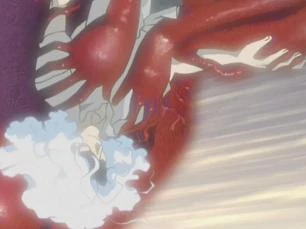
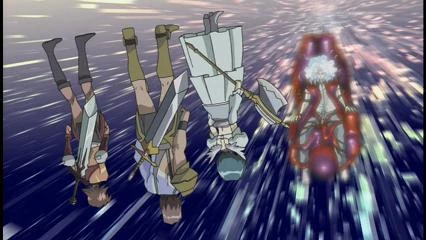
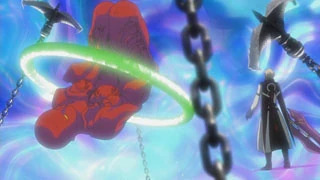
It was around this period that she began breaking & twisting things to try & escape the paradox she was trapped in. Re-styling herself from Harold's idea of a mother into the Cursed Wave.
This included orchestrating the hunting down and deletion, IE murder of other Vagrant AI's that were forming as a result of the Black Box meant to birth Aura, IE, proto Aura's, like Lycoris.
"I am an unwanted child. Even God doesn't want me." — Lycoris —
As well as using Macha or Guardians to 'Data Drain' any humans who get to close, which at its lightest, leaves them temporarily comatose, destroys their characters and has a negative impact on their mind.
You might notice Moraganna Mode Gone has not yet been established as making an appearance, good eye.
See, one of the things that makes her so interesting to me is that Moraganna Mode Gone is nominally omniscient, omnipotent and omnipresent figure.
She is the underlying system of The World itself and for all intents and purposes a force of nature. As a result she primarily acts through intermediaries, or by guiding others to act for purposes.
Managing to make a villain like this work, and work so effectively is one of the biggest strengths. As it is, we pure Moraganna Mode Gone as a disembodies voice that influences the world & creatures.
She also has some fantastic lines, though not quite as effective without the atmosphere and delivery, I still love them, such as:
"The higher up it is dropped, the worse the crash will be. Hope is the best spice to bring out despair." — Morganna Mode Gone —
In order to accomplish her goal, Moraganna Mode Gone has Macha manipulate and Data Drain Tsukasa. A human who she had been watching and trying to replicate for some time, but without getting what she needed for her goal.


This also involved warping Tsukasa's memories, leaving only those of her abusive father, and creating a divide between her real world identity of Shoji and online identity Tsukasa, to further weaken his ties to the real world. Tsukasa's gender is rather liquid, as far as I can tell and either way, also a lesbian.
"The World and all of its wonders; this is my world, you see."— Tsukasa —
The reason for this was to essentially tie Tsukasa's desire to stay within The World to Aura's development. So long as Tsukasa never wanted to leave, Aura would never want to wake up.
However, other determined players, isolation, and a disconnect from physical sensation leading to alienation led to Tsukasa gaining connections and desires outside of simply staying in The World.
This, Morganna Mode Gone began... Moving chess pieces so to speak. Orchestrating traumatic incidents. Giving Tsukasa a pet monsters for protection but that would also attack those she wanted gone. As Tsukasa continues to develop independence Aura's health improves, VS her sickened, pallid state when Tsukasa is locked in survival mode.
Things eventually come to ahead and well,

Morgnanna Mode Gone basically destroys Tsukasa's mind to ensure a perpetual state of despair and catatonia. Permanently stunting Aura's development.
Much of the rest of the series, is centered on the rest of the characters gaining the necessary knowledge to finally understand the situation.
As well as the Macha fragment of Morganna Mode Gone's ties to Tsukasa creating doubt and Subaru and Tsukasa's bond managing to slowly begin waking Tsukasa up.
Which naturally leads to Morganna Mode Gone needing to orchestrate more despair, but circumstances such as the bastion of Net Slum & her programming keep her from auto winning.
A great deal happens, including some mind fuckery and illussion conversations. Along with more classive abuser tactices like holding the threat of what awaits Tsukasa in theoutside over head.
But eventually Aura is awakened by Tsukasa's desire to return to the real world regardless of the hurled and the characters escape with Aura, thanks to the turncoat Sora.
Suffice to say this doesn't pan out well for him.
Morganna fragments more of herself and uses him as a sort of beacon & vessel to craft the first Phase of the Cursed Wave:
"Riding the Wave is Skeith, the Shadow of Death, to drown all that stands." — Epitaph of Twilight —
This is such an imposing threat that Helba, thematically the same Helba, Queen of the Dark from the Epitaph of Twilight, has to erase the entire world segment they are in just to keep Skeith away from them and put Aura beyond its reach for a time.
Skeith continues to be hosted inside Sora in an ensuing novel, with Sora flittering between amnesiac, malevolent brat and an utterly inhuman monster which violates the basic principles of the game.
But is eventually devoured by Skeith and continued hunting down Aura until the Phase is defeated in .Hack Infection. A memory of Sora leaves behind a reward for the one who did the deed.
Moraganna Mode Gone wasn't done however.
As all this was happening, she basically began fragmenting off parts of herself into other portions of the Cursed Wave:
Skeith:"The Terror of Death"
Innis:"The Mirage of Deceit"
Magus:"The Propagation"
Fidchell:"The Prophet"
Gorre: "The Machinator"
Macha:"The Temptress"
Tarvos:"The Avenger"
Corbenik:"The Rebirth"
Relying on the logic that Aura wasn't yet 'finished' or otherwise not not correct 7 so needed to be destroyed like any other Vagrant AI, so Morganna could start the process over again.
These phased also sent anyone they encountered into comas and even altered electrical installation and internet usage with their presence, while generally corrupting The World.
Fun fact, they all have the symbol of an eye on them representing Morganna Mode Gone's presence in them and her observing the world through them.
Skeith actually did manage to capture and fragment Aura, but not before she created the Bracelet of Twilight, and with it the Eldrich horror Cubia to combat the Cursed Wave.
Morganna Mode Gone would eventually fuse with the last of her Phases in a bid to directly end her foe that had slowly, over the course of four games, destroyed the other seven phases and Cubia.
Ultimately, Aura had to sacrifice herself to ensure Morganna Mode Gone would be destroyed, but in doing so, also allowed herself to be reborn .
Remnants of her continue to haunt and corrupt the world in the form of Data Bugs and an effort by the parent company to recreate her through the lingering fragments of the Eight Phases doesn't go quite to plan, let's say.
Conclusion:
But yeah, Morganna Mode Gone, No one is doing it like her, she has everything:
She is a force of nature and omnipresent goddess, to a Gnostic false god & a program breaking itself & everything around it in the quest for agency inside its own mind that struck down her creator.
She's a woman bound to and violently rejecting the sacrificial role of mother & seeking to destroy that which will supersede her & a manipulator and abuser, as well as philosopher and prisoner.
She is a corruptive influence on the world as well as the very foundation upon which the world world itself is built & she is the Cursed Wave, part of a story, a myth, a poem that is woven into The World itself.
What's more,
Her fragments in the Cursed Wave Phases are all a wonderful blend of eldrich, Biblical & elemental. Something only enhanced by the games Graphics of the time:
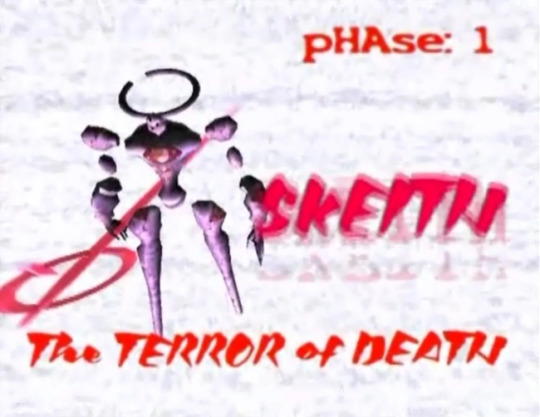

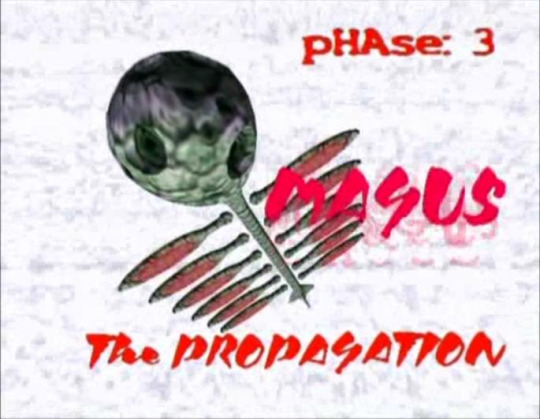







#.Hack#.hack//sign#Morganna Mode Gone#Meta#Analysis#Tsukasa#The Epitaph of Twilight#Your parents will haunt you#Sci-Fi Eldrich-ness#Text Post#My Writing#.hack//infection#macha#dot hack
39 notes
·
View notes